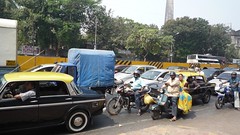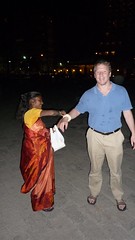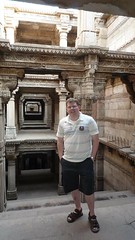Posts by admin
Rules of the road: Ahmedabad vs Mumbai
India 8: Indian driving styles
I’ve never seen traffic anything like the traffic in Ahmedabad. Not because it’s chaotic, but because they seem to have some set of unwritten rules that actually produce order from the chaos such that people rarely crash into one another. In Ahmedabad probably only a quarter of the vehicles are cars as we’d know them. Most are auto-rickshaws or motorbikes, and the rest are either tiny trucks shorter and narrower than Western cars, or a variety of thrown-together carts pulled by camel, cow, three-wheeled bicycle or even pulled by hand. There is no such thing as lane discipline. Since the average vehicle size is so much smaller, roads are typically filled four or five vehicles across. People cut into whatever gaps are available, bipping their horns as they do so to say “watch out, I’ve got this space”. I never heard anyone beeping out of frustration. The only rule I could discern is that like at sea, smaller vehicles give way to bigger vehicles.
The amazing thing is that there is no road rage to speak of, and while the vehicles seem to all look a little battered and dented, I only saw one bump the whole time we were there. The thing that stands out in my mind is that people seemed to just expect other people to cut them up, and accepted it graciously. I wondered what it would be like if we had such a system in the West – would there be fewer accidents? As we got out of the city I realised that one of the reasons it worked is that the traffic is fairly slow, so people have more time to react. Once you get out of the centre with vehicles at speed it gets a little more hairy. But still, it was very interesting to observe.
Mumbai, on the other hand was a completely different kettle of fish.
Read MoreThe Mumbai Milk Scam
India 7: The lengths people will go to, to con a tourist
Mumbai, Friday night, after dark.
Our “cool cab” drops us off by the Gateway of India. The moment we get out the taxi, a man with a four foot yellow balloon with green spots asks us if we want to buy one. He slaps it as if to demonstrate what we’re missing out on. Unsurprisingly we said no. Moments later, a young Indian women approaches us and introduces herself and starts trying to tie flower garlands around her wrists. We refuse and walk away but she is persistent. We say that we don’t want to buy them but she insists, she says don’t worry, it’s a gift. For Diwali. Ok, we say, thank you, and walk away, but we’re sure this won’t be the last we see of her. We walk down the seafront and notice she is following us, about twenty paces behind. We walk for a good ten minutes and she is still following us.
Eventually the seafront road turns inland and on our left, shopkeepers sell their wares onto the street, on small tables and stands. The girl approaches us again and says in stilted English “Can you buy milk for me?” pointing at a carton of powdered milk on a shopkeeper’s stall. It’s for my little brother.
Read MoreA night out in Mumbai, local-style
India 6: Mumbai “Beer Bars” and Extreme Culture Shock
As you may have already gathered, after a week in Ahmedabad we still hadn’t been able to do the work we set out to do, so we were told to fly to Mumbai and do some installations there. Mumbai is a different world from Ahmedabad – a global metropolis – but that’s for another post. This post is about a strange experience we had on the Friday night after we arrived. My Indian colleague Lakshmi and his friend Puru took us out “on the town” in Mumbai to show us how Indian guys enjoy themselves. The first stop was a place called “L.P. Restaurant Bar” in Andheri.
However when we got upstairs we found something that wasn’t quite what we expected. We were ushered into a small room about the size of a pub function room. On a raised stage in the corner, an Indian band played and sang something that sounded like a blend of karaoke, Bhangra beats and europop. Disco lights flashed around the room. We were shown to our seats on upholstered benches which lined the walls of the room. In front of us was an oval glass table with ornate gold-painted metal carvings for legs, of Adonis and Aphrodite like figures. At various locations around the room stood about ten waiters dressed in beige Noel-Coward lounge suits.
Read MoreAdalaj Wav Stepwell
India 5: Is it a temple? Is it a tomb? No, it’s a stepwell
Just outside of Ahmedabad on our way to the Nature Park we visited a small plain looking temple, at the driver’s suggestion. It was a square building made of white bricks, nicely decorated inside with bright coloured garlands and mirrored. As we were about to leave I noticed some steps down through an iron gate. What I saw then was absolutely breathtaking and I realised this is what we had come to see.
Descending five storeys down into the ground, but open to the sky, was a series of pillars and arches on a huge scale. It felt like something you might see in ancient Egypt or in an Indiana Jones film. I certainly had some slight nervousness as I descended down the steps and it got darker and darker.
Read MoreLook at the strange cow-eating white men!
India 4: Strangers in a strange land
From the first night Steve and I went for a walk around Ahmedabad, we noticed that people were looking at us a little strangely. Not with any kind of negativity or judgement but more a sort of genuine fascination – the way you might find your eyes drawn to a person with bright green hair or an unfortunate birthmark. It took a little getting used to. After a couple of days it struck us – we were the only white people in town – even in the hotel. It seems the local people rarely see any non-Indians.
It turns out that Westerners rarely come to Gujarat, so in a way it was the ideal introduction to India. We realised just how rare it must be when we asked a rickshaw driver to take us to Le Meridien and he’d never heard of it or been there, even after we got there (Le Meridien is the most expensive hotel in town).
But it was also interesting to realise that we’d been there a couple of days without even realising we were in a minority. I found that quite weird at the time – my last experience of being in a minority was in Atlanta, Georgia, USA where everyone was black. I felt quite nervous and like I stood out, I was acutely aware of being different. Not so here. There’s something about the people and their attitude that makes you feel very safe and at ease. It would take me a couple more weeks of being in India to really be able to put it into words.
On our first evening as we sat in a restaurant a little Indian girl of 10 or so years old and said in her best attempt at English. “Hello. What is your name?”. Her mother stood behind her and looked on proudly. We introduced ourselves, asked her name, exchanged smiles and she went away happy. This sort of thing happened all the time.. Children would call out “Hello How Are You” in the street as we walked past. We even had a few shouts of “Welcome to India!” which was really touching. But this was nothing compared to what happened to us at Lothal.
Read More






